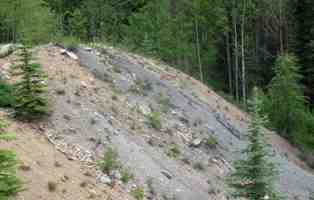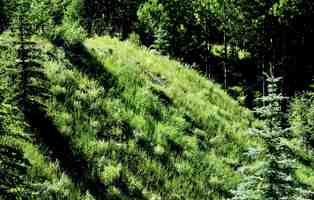Healing power of biochar turns toxic mine tailings into lush greenery near Aspen
What was once a wasteland of arsenic, cadmium, lead and zinc on a steep mountainside that abuts Castle Creek is now a haven for natural grasses and wildflowers that have stabilized the slope and drastically reduced the risk of the heavy metals crashing into the city's main water supply.
The striking change of scenery around Hope Mine is the result of the first whole-scale reclamation project ever attempted in the United States, and possibly the world, using biochar — a type of charcoal produced through the thermal treatment of organic material in an oxygen-limited environment.
“We really were surprised how aggressive the regrowth was,” said John Bennett, executive director of For The Forest, which teamed up with Carbondale-based Flux Farm Foundation at the request of the U.S. Forest Service, which is exploring new ways to partner with private groups to reclaim landscapes. “We did not expect waist-high grass in the very first summer. We thought it would take longer.”
Not only is biochar restoring the ecology and containing the mine tailings that fan down toward Castle Creek but experts say it is also immobilizing the heavy metals long enough so that they naturally degrade and it is sequestering carbon that would otherwise escape into the earth's atmosphere.
The success at the aptly named mine is providing hope for federal officials looking to clean up an estimated 23,000 abandoned mines in Colorado and many more that scar the American West.
“Too many communities still live with the ghosts of their mining pasts — the abandoned mines that continue to threaten public safety and livelihoods that depend on clean watersheds — which is why I'm trying to make it easier for volunteers and Good Samaritans to help clean up these sites,” Sen. Mark Udall, D-Colo., told the Colorado Independent this week. “We need exactly this kind of public-private collaboration to fix a problem neither side has been able to tackle alone, and to make a real difference in our communities. Clean streams mean the fish can return, people can drink the water, and tourists will bring dollars and jobs back into these communities, making it a win-win effort."
For years, Udall has been working to introduce so-called Good Samaritan legislation to provide legal protection for nonprofit and others groups who clean up water contamination from old hardrock mines. So far, the mining industry and even environmental groups concerned that extraction companies could abuse the law have stymied the senator's efforts. More recently, Udall and Sen. Michael Bennet, D-Colo., have encouraged the Environmental Protection Agency to use its administrative discretion.
“The EPA has existing guidance that encourages potential Good Samaritans to enter into voluntary agreements with EPA or federal land management agencies that helps to facilitate Good Samaritan cleanups,” the senators recently wrote in a letter to the EPA. “We believe that the guidance could be updated to provide additional clarity to Good Samaritans that compliance with such agreements is sufficient to satisfy requirements that help protect environmental quality, including water quality.”
In the case of the Hope Mine project, For The Forest is working under a memorandum of understanding with federal authorities that Bennett believes provides “a reasonable level of protection.”
But to get more work done, he said, Good Samaritan legislation is “really wise and certainly needed.”
“The problems in forest restoration are so large that no one entity can do it alone. The Forest Service is very quick to admit they don't have the resources and no one community certainly does,” Bennett said.
“It's going to take a lot of people working together. It's hard to expect someone to step forward and volunteer to help restore the ecology of these landscapes when the prospect of litigation hangs over their head in the event something goes wrong in some future year despite their best intentions.”
![]() 0 Comments on "Healing power of biochar turns toxic mine tailings into lush greenery near Aspen"
0 Comments on "Healing power of biochar turns toxic mine tailings into lush greenery near Aspen"
Be the first to comment below.




 Vail Town Council to weigh new plan to redevelop T...
Vail Town Council to weigh new plan to redevelop T...  All about indexes
All about indexes  Transforming your social security into a winning r...
Transforming your social security into a winning r...  Pass sales, real estate transactions, revenues inc...
Pass sales, real estate transactions, revenues inc...  Vail Valley native with passion for Biophilic inte...
Vail Valley native with passion for Biophilic inte...  Beaver Creek starts work on new summer activities
Beaver Creek starts work on new summer activities  Land Trust, ECO Trails, Vail Resorts team up to cl...
Land Trust, ECO Trails, Vail Resorts team up to cl...  EUROVISION named Host Broadcaster for 2015 World A...
EUROVISION named Host Broadcaster for 2015 World A...  Vail Resorts brings back Lindsey Vonn's 'School of...
Vail Resorts brings back Lindsey Vonn's 'School of...  Hundreds turn out for 2015 World Championships vol...
Hundreds turn out for 2015 World Championships vol...  Eagle County Senior Health Expo and 9th Annual Hea...
Eagle County Senior Health Expo and 9th Annual Hea...  Final race of Vail Mountain Trail Running Series s...
Final race of Vail Mountain Trail Running Series s...  Before you write your will ...
Before you write your will ...  2015 World Ski Championships volunteer recruitment...
2015 World Ski Championships volunteer recruitment...  Ascent Sotheby’s International Realty in Vail an...
Ascent Sotheby’s International Realty in Vail an...  CDOT outlines road closures for local stages of US...
CDOT outlines road closures for local stages of US...  Italian artist creates unique trophies for Vail, B...
Italian artist creates unique trophies for Vail, B...  Vail Recreation District once again hosting Jake W...
Vail Recreation District once again hosting Jake W... 

